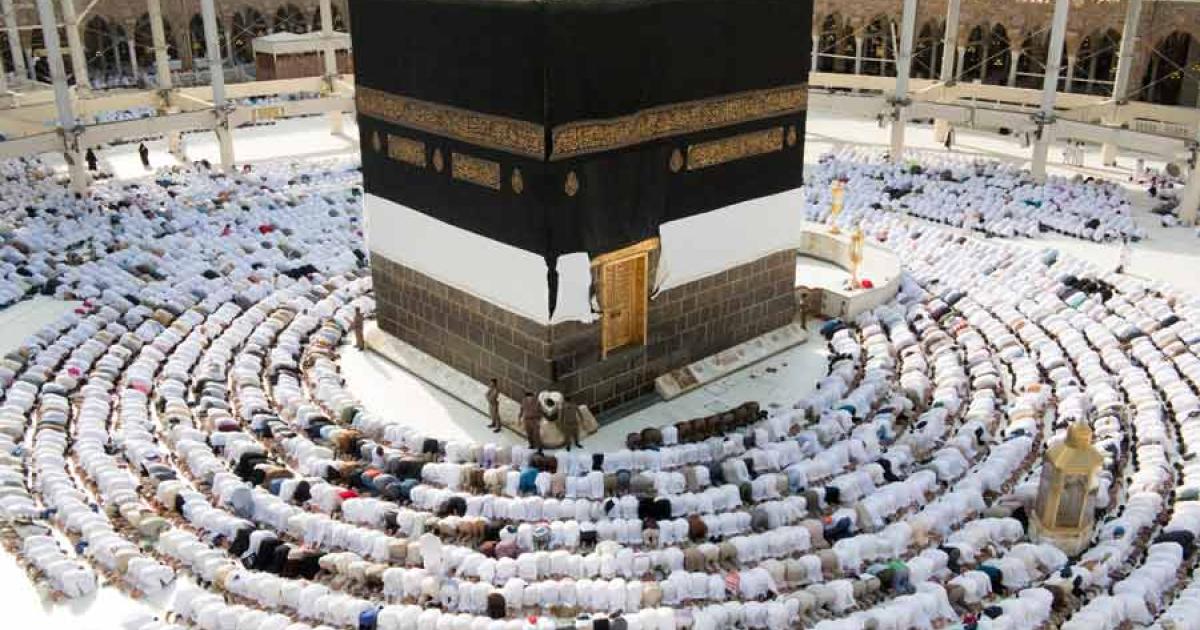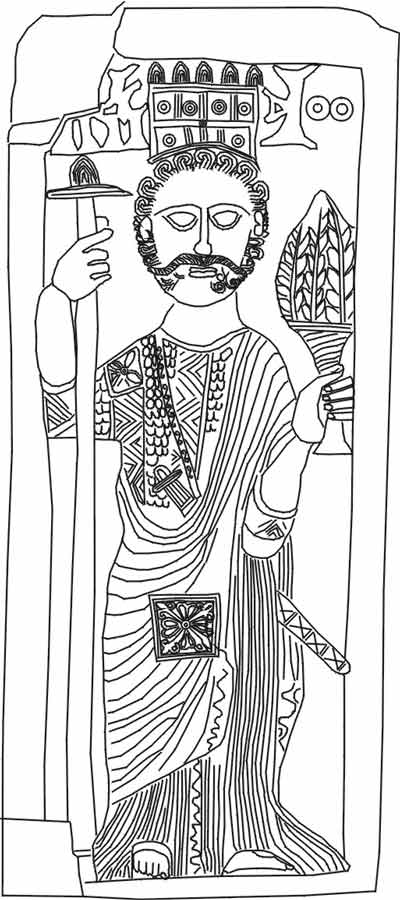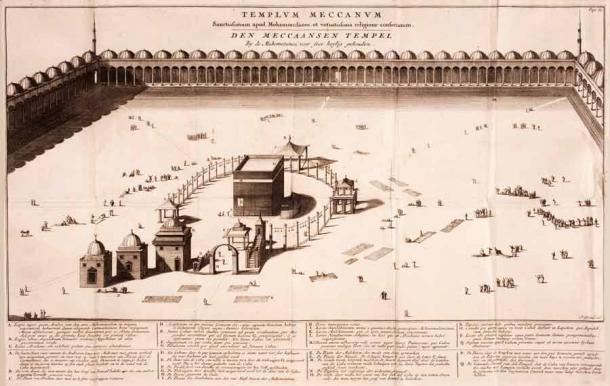
How Two Jewish Rabbis Respected and Protected the Ka'bah of Islam
Before I can explain Ibn Kathir’s account of the two rabbi who protected the Ka’bah, I have to relate something about the Jews in Arabia in the five centuries before the birth of Prophet Muhammad.
In 2014, a French-Saudi expedition studying rock inscriptions around Bir Hima – a site about 100 kilometers north of the city of Najran in southern Saudi Arabia; discovered what could be the oldest texts written in the Arabic alphabet.
At least two of the early Arabic petroglyphs discovered, cited dates in an ancient calendar. Expert epigraphists quickly calculated the oldest one to the year 469 or 470 AD in the western calendar.

Assyrian warship from 700-692 BC, when Saudi Arabia was still pre-Islamic. (No machine-readable author provided. World Imaging assumed (based on copyright claims) / CC BY-SA 3.0)
From Pre-Islamic Arabia To A Jewish Kingdom And The Ka’bah
The general picture of this period in pre-Islamic Arabia is one of tribal feuds and anarchy, dominated by jahilliyah – ignorance – lawlessness, illiteracy and pagan cults. For generations before Mohammed’s “hijra” from Mecca to Medina in 622 AD, the societies and centralized states in Europe and the Middle East were weakened by incessant warfare between the Christian Byzantine and Zoroastrian Persian empires.
- The architectural marvel of Madain Saleh and the enigmatic Nabataean people
- Archaeologists Discover that Earliest Known Arabic Writing Was Penned by a Christian
One key, but often forgotten, player in Arabia at that time was the kingdom of Himyar. Himyar was established around the 2nd century AD, and by the 4th century had become a regional power. Based in today’s Yemen, Himyar had conquered neighboring states, including the ancient kingdom of Sheba (whose queen met with Solomon).
In a recent article titled “ What kind of Judaism in Arabia?” Christian Robin, a French epigraphist and historian who also a leader of the expedition at Bir Hima, says most scholars now agree that, around 380 AD, the elites of the kingdom of Himyar converted to Judaism.
The Himyarite rulers may have seen in Judaism a potential unifying force for their new, culturally diverse empire, and an identity to rally resistance against creeping encroachment by Byzantine and Ethiopian Christians, as well as the Zoroastrian empire of Persia.

Sabaean inscription with Hebrew writing: "The writing of Judah, remembered for good, Amen." (Christian-Julien Robin, President of the Academy of Inscriptions and Belles-lettres (France). He has sent his written permission to Wikimedia Commons to publish the image on Wikipedia. / CC BY-SA 4.0)
Conversion to Judaism in the Himyarite Capital of Zafar
It is unclear how much of the population converted, perhaps 10-20% perhaps 30-40%. What is sure is that in the Himyarite capital of Zafar (south of Sana’a), references to pagan gods largely disappeared from royal inscriptions and texts on public buildings and were replaced by writings that refer to a single deity.
- The End of Ancient Judaism: The Captivity
- Babylonian Talmud is More Detailed On The Birth Of Jesus Than The Bible
Using mostly the local Sabean language (and in some rare cases Hebrew), this God is alternatively described as Rachmanan – the Merciful – the “Lord of the Heavens and Earth,” the “God of Israel” and “Lord of the Jews.” Prayers invoke God’s blessings on the “people of Israel” and those invocations often end with shalom and amen.
For the next century and a half, the Jewish Himyarite kingdom expanded its influence into central Arabia, the Persian Gulf area and the Hijaz (the region of Mecca and Medina), as attested by royal inscriptions of its kings that have been found not only at Bir Hima, just north of Yemen, but also near what is today the Saudi capital of Riyadh.
But growing outside pressure ultimately took its toll on the Jewish Arab leadership of Himyar. Sometime around the year 500, it fell to Christian invaders from the Ethiopian kingdom of Aksum. In a last bid for independence, in 522, a Jewish Himyarite leader, Yusuf As’ar Yath’ar, rebelled against the puppet Christian ruler enthroned by the Ethiopian negus and destroyed the Aksumite garrison. He then besieged Najran, which had refused to provide him with troops, and in revenge massacred part of its Christian population.

Relief from Zafar which shows a man wearing a crown, during the era when area was Christian. (Pyule / CC BY-SA 3.0)
Discovering the Inscription From Yusuf And The Ka’bah
In 2014, the French-Saudi expedition at Bir Hima discovered an inscription recording Yusuf’s passage there after the Najran massacre as he marched north with 12,000 men into the Arabian desert to reclaim the rest of his kingdom. Christian chroniclers recorded that around 525 AD the Ethiopians defeated the rebel leader.
For the next century, Himyar was a Christian ruled kingdom that continued to dominate Arabia. In the middle of the sixth century, one of its rulers, Abraha, marched through Bir Hima, leaving on stones, dated 552 AD, records of the many locations he conquered, including Yathrib, a desert oasis that even years later was still called Yathrib, the City of the Jews, and that just 70 years later would become known as Madinat al-Nabi (the City of the Prophet), or, more simply, Medina.
What kind of Judaism did the Jews of Himyar practice? Did they observe the Sabbath? Or the rules of kashrut? Robin, the French epigraphist, writes in his article that the official religion of Himyar may be described as “Judeo-monotheism,” “a variety of Judaism” that followed many of the Judaism’s basic principles, rituals and prohibitions (daily prayers, circumcision, sexual purity, pilgrimage, charity, Shabbat and Holydays, a ban on religious images and eating pork). But like Reform Judaism today, the Himyar Jews did not follow most of the restrictions that Orthodox rabbis had added to the Torah of Moses.
With this background we can better understand Ibn Kathir account of the two rabbis who protected the Ka’bah from destruction.

A panoramic view of Mecca where the Ka'bah was built, and eventually "saved" by two Jewish rabbis. (Khalili Collections / CC BY-SA 4.0)
The Two Rabbis Who Fought Against Destroying the Ka’bah
The Tafsir of Ibn Kathir (born 1302 AD) is one of the most widely used explanations of the Qur'an in the Arab world today. Recently, while studying Qur'an with ibn Kathir's Tafsir, I learned of an amazing event involving two rabbis and the Holy Ka'bah. While explaining a Qur’an verse (44:37) ibn Kathir relates the following events:
“One of the Tubba` (rulers) left Yemen and went on a journey of conquest until he reached Samarkand, expanding his kingdom and domain. He is the one who founded Al-Hirah. It is agreed that he passed through Al-Madinah during the days of Jahiliyyah. He fought its inhabitants, but they resisted him; they fought him by day and supplied him with food by night, so he felt ashamed before them and refrained from harming them.
“When (on his return) he passed by Makkah, he wanted to destroy the Ka`bah, but the rabbis told him not to do that. They told him about the significance of this House, that it had been built by Ibrahim Al-Khalil, peace be upon him, and that it would become of great importance through that Prophet who would be sent towards the end of time.
“So he respected it, performed Tawaf around it, and covered it with a fine cloth. Then he returned to Yemen and invited its people to follow the religion of guidance along with him. At that time, the religion (Judaism) of Musa, peace be upon him, was the religion followed by those who were guided, before the coming of the Messiah (Jesus), peace be upon him. So, the people of Yemen accepted the religion of guidance (Judaism) along with him.”
Although for more than 60 years I have been studying the Qur'an and reading other Islamic books, I had never heard of these amazing events.
As a Reform Rabbi I believe that Jewish spiritual leaders should modify Jewish tradition as social and historical circumstances change and develop. I also believe we should not make religion difficult for people to practice by adding an increasing number of restrictions to the commandments we received at Mount Sinai.
These are lessons that prophet Muhammad taught 12 centuries before the rise of Reform Judaism in the early 19th century Germany. Although most Jews today are no longer Orthodox, if the Jews of Muhammad's time, had followed these teachings of Prophet Muhammad, Reform Judaism would have started 1,400 years ago.

An old drawing of the Ka'bah in Mecca. (Peace Palace Library / Public domain)
Two Rabbis of the Tubba Jewish Kingdom Protected the Ka’bah
God willing, ibn Kathir's narrative (44:37) about how the two rabbis from the Jewish kingdom of Tubba in Yemen protected the Ka’bah from destruction will set a good example for Arab and Jewish leaders today; and inspire them to seek reconciliation instead of revenge.
- The Meaning of Mecca, Islam’s Holiest City
- The Life of the Prophet Muhammad: Spreading Islam from Mecca to Medina
That would bring closer the fulfillment of the 2500-year-old wonderful vision of the Jewish Prophet Isaiah: “In that day there will be a highway from Egypt to Assyria. The Assyrians will go to Egypt, and the Egyptians to Assyria. The Egyptians and Assyrians will worship together. In that day Israel will join a three-party alliance with Egypt and Assyria, a blessing upon the heart. The LORD of Hosts will bless them saying, “Blessed be Egypt My people, Assyria My handiwork, and Israel My inheritance.”…(Isaiah 19:23-5)
Top image: The Kaaba of Mecca was saved by two Jewish rabbis in a story that shows religious tolerance and wisdom. Source: Jasmin Merdan / Adobe Stock
By Rabbi Allen S. Maller
Allen S. Maller is an ordained Reform Rabbi who retired in 2006 after 39 years as the Rabbi of Temple Akiba in Culver City, California. His web site is: www.rabbimaller.com.
















Comments
Islam as we know it today was not the creation of ‘Muhammad’ but of Caliph Abd al-Malik ibn Marwan (646 - 705). He was an Umayyad. The true history of islam was erased by Abd al-Mallik.
Islam originated much further north in Hira > Mesopotamia. All the earliest mosks are oriented at Petra, not Mecca! The originators of islam were not the Umayyad but Tajis. So Muhammad (Ibn abi Kabsha) was not a trader (tajir) but the head or king of the Tajis.
Go to the YouTube-channel ‘Sneakers Corner’ if you are truly interested in the origins of Islam. Or search the YT video “Have we found the Original Muhammad? Mel thinks so!” > Pfander Films.
The original Muhammad had a (non-trinitarian) Christian mission: retake Jerusalem from the Romans, rebuild the Temple so the Messiah (Jesus) would return on Earth and Israel could lead the nations of the world to Peace on Earth.
Again: Go to the YouTube-channel ‘Sneakers Corner’ if you are truly interested in the origins of Islam. You’ll be amazed!
As a Dutch proverb says: No matter how fast the lie is, the truth will catch up with it!
Γνῶθι σεαυτόν